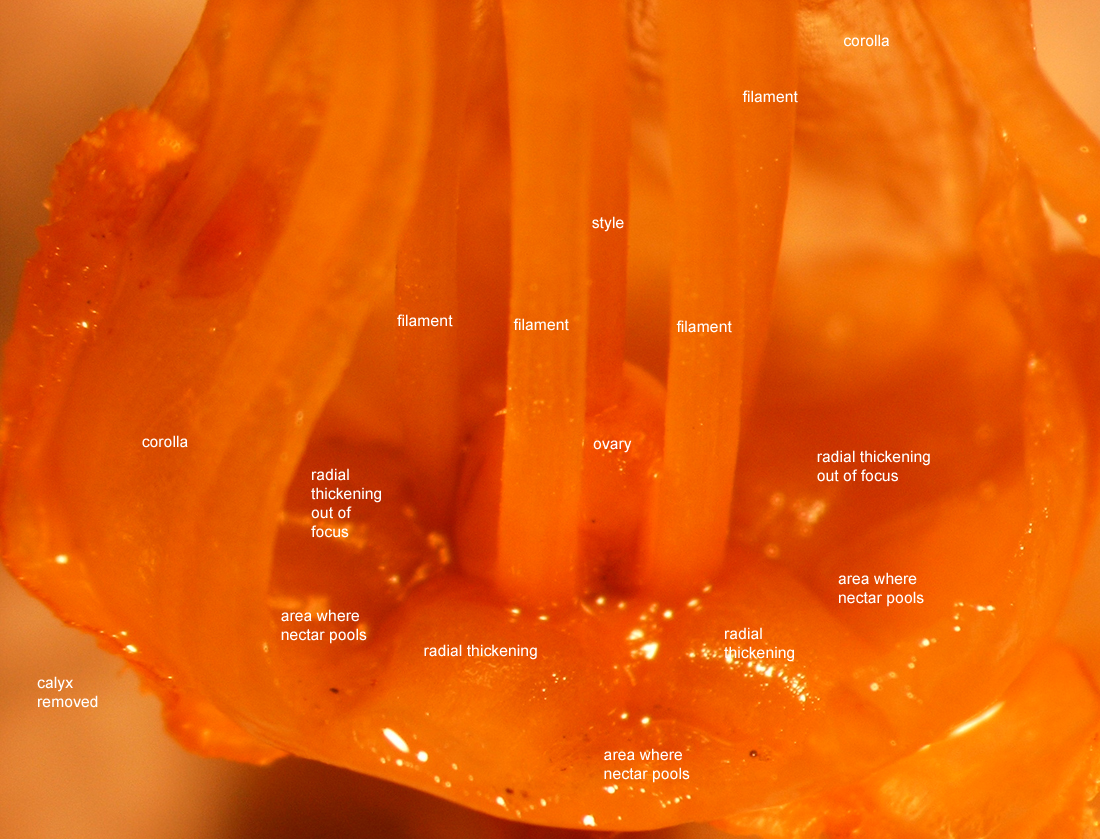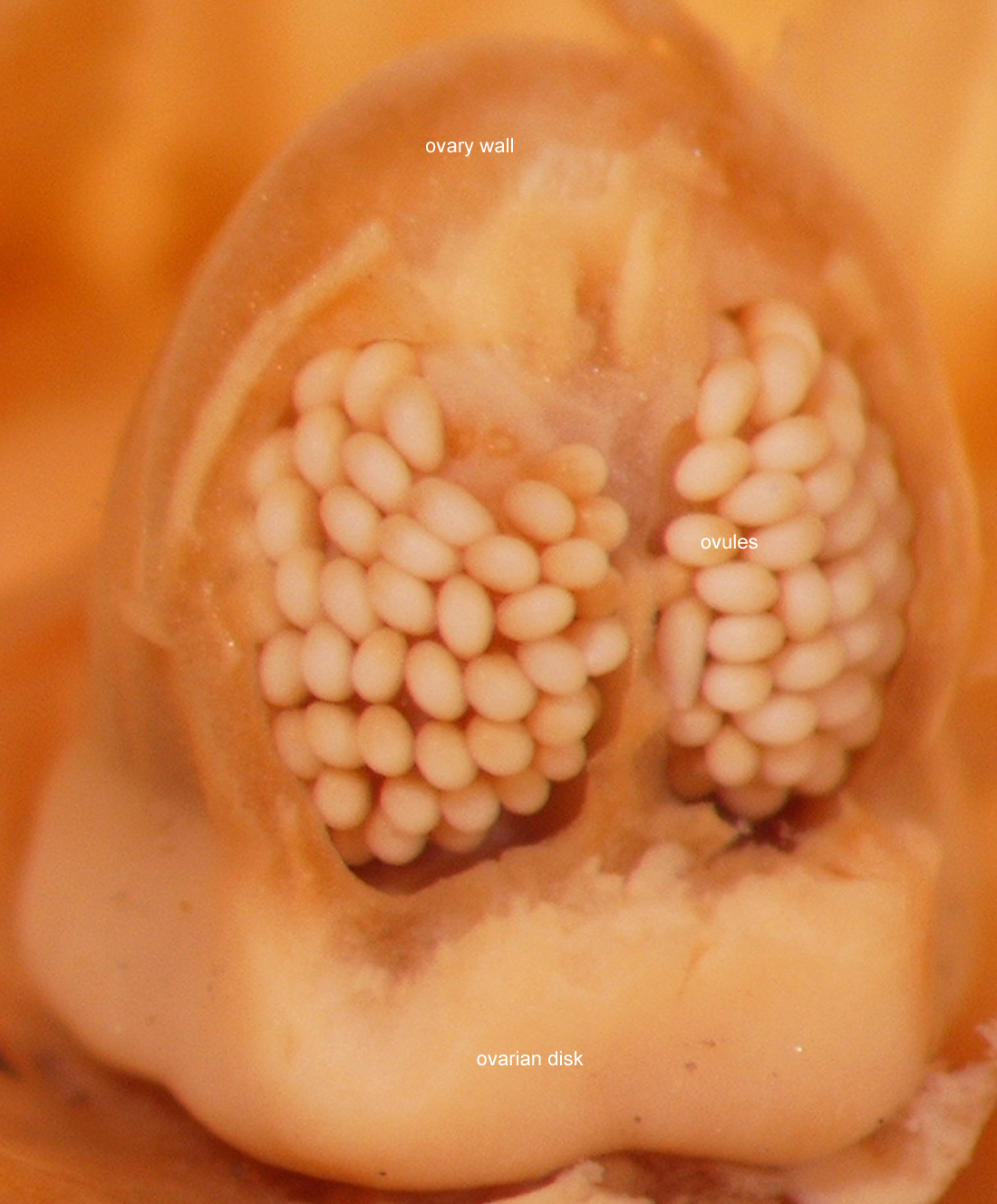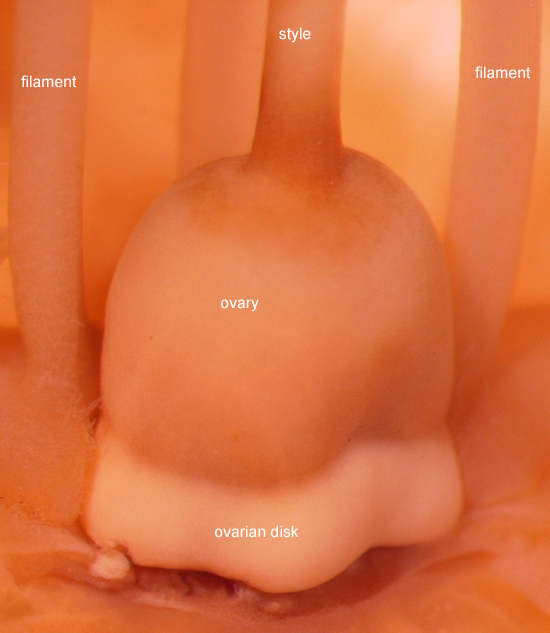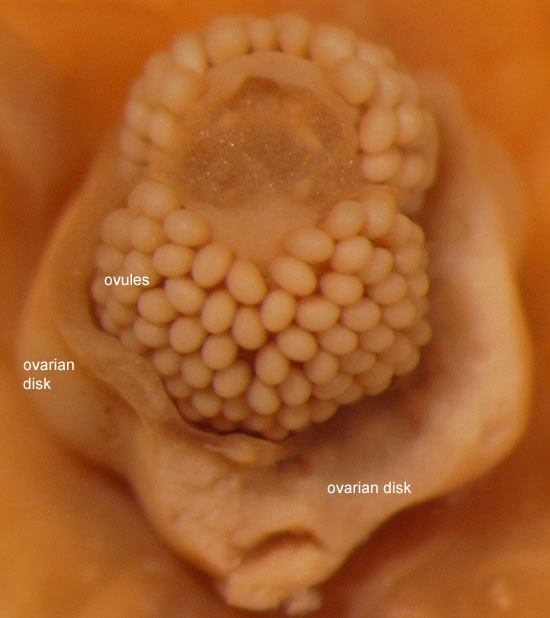Table 1. Description of Jaltomata spooneri.
| Character |
Description |
Figures on this page |
Habit & Height |
Shrub to 2 m, perennial,
growing next to and in / among other plants |
|
Branches, young |
subterete / angled; sparsely hairy, the hairs dendritic, forked and finger (some gland-tipped, most not) |
|
older |
terete, with lenticels |
|
Leaves, size |
the blade to 11.7 cm long X 8.7 cm wide, geminate, papyraceous (sturdier than membranous but not coriaceous) |
|
| shape |
lanceolate or ovate with the apex acuminate, the margin entire to somewhat repand |
|
| hairs |
the blade minutely pubescent, the hairs simple and / or dendritic, the margin ciliate |
|
| petiole |
to 2.7 cm |
|
Inflorescence |
axillary, 2 (-3) flowered |
|
peduncle |
terete, green, to 1.5 cm long, with finger hairs
mostly gland-tipped |
|
pedicel |
green, having 5 raised longitudinal ridges, with finger hairs mostly gland-tipped, to 2 cm long |
|
Calyx at flowering |
green, on flowers of Mione et al. 800 pigmented purple between lobes on abaxial face (showing upward),
the lobes triangular,
23 mm lobe tip across to lobe tip, abaxially a mixture of uniseriate unbranched (finger) and forked hairs all gland-tipped |
|
| shape / position when flowering |
rotate to somewhat reflexed |
3 |
| at fruit maturity |
25 mm from lobe tip across to lobe tip with unripe fruit, possibly somewhat larger with mature fruit |
|
Corolla color |
pale-green, the veins pigmented purple (Mione et al. 800) or unpigmented (Mione et al. 799) |
5 |
shape and size |
tubular, the tube 1.2 - 1.7 cm long on herbarium specimens, 1.5 - 2 cm long measured in the field, 7 - 10.5 mm across perpendicular to the length where widest (herbarium specimens); the limb recurved, to 3 cm in diam on herbarium specimens depending on how the corolla was pressed, 2.5 cm in diam measured in the field |
|
lobes / lobules |
alternating, totaling 10; the lobes cream-green, the lobules cream |
|
|
abaxially (outer) simple usually not gland-tipped but sometimes gland-tipped,
inner extremely short and simple,
the margin ciliate |
|
Stamen length including anther |
to 27 mm long including anther |
|
length stamens exserted beyond distal end of corolla
(applicable if corolla has a well-defined tube) |
commonly to 12 mm, up to 15 mm
(measurements made on pressed specimens) |
1, 3, 7, 8, 9, 10, 11 |
|
yes: radial expansions of the bases of the stamens, adnate to the corolla, create nectar troughs between the radial expansions / thickenings |
12 |
| base expanded laterally? |
no |
|
| filaments |
unpigmented, glabrous |
|
| anther color |
yellow |
|
| anther size |
2.1 - 2.7 mm long (dehisced, herbarium specimens);
3 mm long X 2 mm wide (field notes);
sagittate or not, depending on orientation when pressed |
10 |
| anther mucronate/mucronulate |
mucronulate |
both Mione et al. 799 & 800, field notes |
| insertion of filament |
on the lower ventral face of anther |
|
| anthers of a flower open simultaneously? |
some of the photos taken in Peru (Mione et al. 799 & 800) show some but not all of the anthers of a flower dehisced, thus dehiscence is nonsimultaneous at least in some instances |
|
| pollen quantity per flower |
92,500 - 109,000 (n = 2 flowers) |
Mione et al.799 & 800, counts by Emmett P. Varricchio, 2012, flowers collected in Peru (not grown for study) |
| pollen grain size |
32.5 - 37.5 µm,
mean 34.69 µm |
Mione et al. 800, 18 grains, flower collected in Peru and stored in 70% ethanol, measured 2012 |
| corona |
no |
|
Stigma |
capitate, darker green than style,
bilobed (viewed with a 10X hand lens) |
16, 17, 1, 3, 7, 8, 10 |
Style |
26 - 28 mm long, pale-green |
8, 1, 3, 9, 10, 11,12,16,17 |
Ovary |
green; the disk orangish and about 20 - 30% the height of the ovary |
13, 14, 15 |
Ovules per ovary |
225 - 236 (n = 2 flowers) |
13, 15 |
Nectar |
transparent |
|
| Herkogamy |
only sometimes: several of the flowers in figure 11 show a few mm between stigma and dehisced anthers. |
Fig. 1 no, Fig.11 yes |
| Protogyny |
yes |
3, 10 |
Fruit color (at maturity) and size |
mature fruits not seen, most likely orange (a local person described the ripe fruit as "amarillo")
to 1.3 cm diameter but fruits measured were unripe and so mature fruits may be slightly larger |
6, 9 |
Seeds per fruit |
no data |
no data |
Seed Size |
no data |
no data |
Chromosome number |
no data |
no data |
Growability in Connecticut, USA |
no data |
no data |
How long does it take from flower to ripe fruit? |
no data |
no data |
Self-Compatible? |
no data |
no data |
Seed Germination |
no data |
no data |
Ratio of pollen to ovules |
411 - 462 (n = 2 flowers) |
Mione et al. 799 & 800 |
| Character |
above, Description of J. spooneri |
Figures on this web page |
Table 2. Specimens Studied, grouped by Department then province, then oldest to most recent
| Department |
Province |
Locality |
altitude m |
habitat |
date |
collector |
Data Entry |
| Cuzco |
Quispicanchi |
Marcapata |
|
no data |
15-16 Feb 1929 |
A. Weberbauer 7789 (NY, US) |
July 2012 |
| Cuzco |
Quispicanchi |
alrededores de Marcapata |
3100 |
laderas de arbustos |
7 Dec 1962 |
C. Vargas C. 14039 (CUZ) |
Jan 2011 |
| |
|
|
|
|
|
|
|
| |
|
|
|
|
|
|
|
| Puno |
Carabaya |
Pte. Ackopampa |
3425 |
borde camino pedregoso |
31 Dec 1947 |
C. Vargas C. 6978 (CUZ, US) |
Jan 2011 |
| Puno |
Carabaya |
En Chicha Ccori, entre Ollachea y Macusani |
2800 |
no data |
17 Feb 1983 |
C. Ochoa & A. Salas 15075 (US) |
July 2012 |
| Puno |
Carabaya |
Dist. Ayapata; Comunidad La Escalera
S 13 50.23, W 70 19.1 |
3300 - 3700 |
Pajonal estacionalmente húmedo con presencia de arbustos. Ladera húmeda. |
5 Mar 2004 |
E. Ortiz V. et al. 5 (HUSA) |
Jan 2011 |
| Puno |
Carabaya |
Dist. Ayapata; Comunidad Kana, Cerros al O de la población. S 13 47.91, W 70 18.79 |
3300 - 3500 |
Ladera pedregosa estacionalmente húmeda, dominada por herbáceas. Ladera húmeda. |
6 Mar 2004 |
S. Vilca C. et al. 45 (HUSA) |
Jan 2011 |
| Puno |
Carabaya |
La Escalera / Kana,
S 13 50.07, W 70 19.65 |
3598 |
along trails to homes, around homes, roadside |
10 Jan 2010 |
T. Mione et al. 800 (HUSA);
Leiva G. et al. 4656 (HAO) |
Jan 2010 |
| Puno |
Macusani |
Road from Ollachea to Macusani, S 13 50', W 070 29' |
3200 |
Cloud forest remnants and cultivated land in between |
1.2.2000 |
M. & K. Weigend 2000/100 (HUSA) |
Jan 2011 |
| Puno |
Sandia |
Limbani |
3000 |
no data |
22 Nov 1938 |
C. Vargas C. 1299 (CUZ, MO) |
Jan 2011 |
| Puno |
Sandia |
Environs of Limbani |
3400 |
close to fences and dwellings
|
21 Nov 1938 |
C. Vargas 9654 (G) |
July 2012 |
| Puno |
Sandia |
En el camino de Machu Tticani a Patanbino |
3300 |
|
19 Feb 1983 |
C. Ochoa & A. Salas 15085 (US) |
July 2012 |
| Puno |
Sandia |
from Patambuco drive 3.6 km out of town to Escuela San Luis, ca. 300 m from school along path to valley of Río Rumichaca,
14 23 W, 69 36 S. |
3500 |
in old rock wall |
27 Feb 1998 |
D. M. Spooner et al. 7402a (WIS) |
July 2012 |
| Puno |
Sandia |
Patambuco
S 14 21' 41.5, W 69 37' 18.4 |
3594 - 3602 |
roadside, rocks |
9 Jan 2010 |
T. Mione et al. 799 (HUSA);
Leiva G. et al. 4655 (HAO) |
Jan 2010 |



